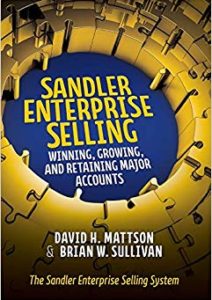The scene and the script are very common. A sales manager is approached by a sales rep pushing strongly for the pursuit of a large enterprise account opportunity. “It’s right in our power swing”, “We’re positioned to win”, and “It’s ours to lose” ring out in the pitch. Often, after some discussion around performance, the more honest, “I really need to win this” is offered. Emotions, agendas, and begging aside, what’s the logical business rationale to drive the decision to pursue a big deal, and what’s the real business risk?
The president of a firm in Texas recently told me, “Whenever we make the decision to pursue an opportunity, it costs us $30,000. Win or lose, $30,000.” She added, “The most difficult issues for us are identifying the deals that we’re most likely positioned to win and knowing whether to push on or call things to a halt in long, expensive pursuits.”
Of course, as she states, the financial costs of pursuing an enterprise opportunity can be immense. But there’s more – much more. Credibly pursuing large deals involves people – scarce resources whose time is precious. And, when people are engaged in a lengthy pursuit, they are typically unavailable, at least to some degree, for other initiatives which are often delayed or shelved altogether. The opportunity costs, then, of making the bets on which deals to focus on, can be stifling if the wrong choices are made.
It’s critical, then, to be able to identify the deals with the highest probability of success. As such, the ability to target and pursue only the true “profile” deals, those that tightly align to your capabilities, is vital. Your organizational vetting process is critical in leading you to those deals where the likelihood of successful delivery, healthy margins, and robust client satisfaction are greatest. Simply put, it’s a survival skill.
And then there’s knowing when to exit the “wrong” pursuits. Your ability to make these decisions in a logical, measured way is truly fundamental in the enterprise world. Making these Go/No-Go calls cuts off the flow of funds and allows the redeployment of precious resources on true profile initiatives – the higher probability deals.
Your main decision in the initial stages is between early acceleration and early exit. And, practically speaking, there should be no gray area between the two. Stay or go? That’s the question. But how can you know?
It’s all about building a crystal-clear, organization-wide understanding of what your firm does really well, and, what it does not so well. Combined with that candid assessment must be clarity about what constitutes both a true profile account and an opportunity that truly aligns with your strengths. With that clarity embedded in your organization’s DNA, what naturally follows is a practical Go/No-Go process to guide you. Sandler Enterprise Selling’s Pursuit Navigator Tool is a prime example of such a guide as it addresses the key business issues of a potential opportunity by separating them into three workable categories – Client Issues, Selling Team Issues, and Financing/Contract Issues. Cross-functional teams representing the relevant and invested organizational functions then evaluate the issues. This deal forum sets the stage for the collaboration that determines your levels of stability or risk for each issue evaluated. That’s the key. Are you stable…or is there risk in the issues. As an example, do you really have multi-level relationships in the account? Do you clearly understand your competition, their value propositions, and their relationships with the buyer network? And, how about the stipulated contractual guarantees, warranties and penalties – do you really understand their consequences? Think about these questions. How can you not evaluate them? How could you ever consider proceeding on a pursuit without understanding, as best you possibly can, their implications?
And, for the issues where you’ve candidly identified significant risk, the question is what you’re going to do about it. And the answer is that you must build pragmatic mitigation plans to address the doubt and uncertainty – as quickly as possible. No good will come from delaying action on an issue that could cause you harm – the clock is ticking, always.
The results of these actions and efforts, which can often involve candid discussions with the prospect account, will provide you with perspective and clarity about the severity of the dangers you could face. As such, you’ll gain the actionable information you need to make quality, educated Go/No-Go decisions. Of course, some levels of risk are acceptable and expected, but not risks that haven’t been evaluated and reviewed. Not risks that you haven’t taken the time to understand or prepare for. Not risks that you’ve ignored.
With this type of targeted risk mitigation, you either increase your chances of success should you decide to proceed or you clarify your strategically sound decision to forego the opportunity. Such a logical process minimizes the uncertainty and the ambiguity, clearing the way for your team to make measured decisions about embarking on an expensive enterprise pursuit or professionally deferring an opportunity.
As mentioned earlier, in the world of enterprise selling, sound, organizational Go/No-Go decision-making is a survival skill. Early acceleration or early exit. For your organization and all of its stakeholders, making the right call is a gift.
Pipeliner CRM empowers sales teams to make the right call in pursuing deals.Get your free trial of Pipeliner CRM now.












Comments